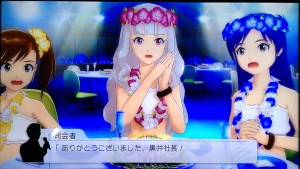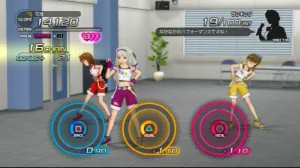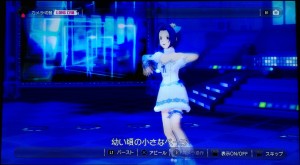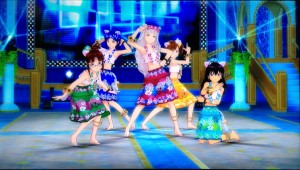
Have you ever dream of raising a Japanese pop idol? If so, Idolmaster is the game that allows you to. Surprisingly, I haven’t heard much about the game even though I have seen other fellow anime bloggers played the actual game. This is mostly because typical Namco refuses to localize the game (and others) for obvious reasons and that it’s originally on the Xbox 360, a console I do not want to own. Sure, a PSP version of the original game and the Nintendo DS spinoff, Dearly Stars eventually came out. What made me interested in playing the game is the Anime that recently finished. When I heard that there is a Playstation 3 version of the second game, I just had to play it. It basically motivated me to learn Japanese and thus, I gave it a spin.
The iDOLM@STER 2 is a “second vision” game in the series that puts a lot of emphasis on “Unity” (or 団結) as shown in the Anime. In this game, you have to create an idol unit with three members (leader and two sub members) and manage them so you achieve the top position in the Idol Academy. Like in the older games, the choices you make are crucial in order to succeed. Since I played the game for most of my winter vacation, I may as well share my thoughts about the gameplay rather than writing a full review.

You can essentially describe this game as a visual novel, rhythm game and a raising simulator smashed together. For a person who has limited Japanese skills, the automatic text is kind of frustrating since you cannot adjust the speed to read it (although you can pause the game to read it) and the lack of furigana. Therefore, you should probably know all the common kanji along with the grammar if you want to enjoy the story. Since I’m still studying Japanese, I ended up taking pictures of the TV screen with my iPhone camera so I can translate it later for practice. Despite this, the core gameplay is still accessible if you don’t know the language thanks to people in the community who worked hard on a strategy wiki for the game and the Project iM@S forums. It was a great help, although I wished I had studied the language a bit more before playing the game, but oh well.
When playing the game for the first time, it had a rather steep learning curve. It actually took me several attempts and a rage quit on the first unit before I got a good result for my first play through. In order to win just the Idol Academy Grand Prix award, you need must focus mostly on two areas before moving onto others and know what the special statuses on the charts. Achieving a Break, Revival or a Keep is very important in order to reach the top 20 and eventually, the top 10. These only come by luck, so you may end up having to reload the game many times until you get it, especially if you want an S rating in Hyper difficulty. Achieving one of these statuses are always associated with specific requirements and events.
Also in the game are lessons, which is narrowed down to three: Dance, Visual and Vocal. Compared to the older games, they are far simpler and easier to master, although the latter can get rather tedious.

For the rhythm section of the game, it’s different compared to others because there is no defined buttons to press. Instead, you decide on what appeal to give (Dance, Visual or Vocal) depending on the multiplier rate and your image stats. Every time you appeal, the multiplier rate goes down. If you get a perfect hit, the voltage meter will raise. Once it gets full, you can do a “Bust Appeal,” which gives you bonus points based on your unit’s Unity Score. Also, you can use memory appeals to raise the voltage meter. If you switch the appeal member and use another one, you can do a memory drive, a technique that becomes very useful in festivals, especially for the Song Princess area festivals (歌姫). Otherwise, the gameplay is fast paced and requires a good amount of strategy for what appeals you should give in order to gain a high score or even victory over the rival.
Aside from auditions as shown in the screenshot, lives work the same. The only differences is that you have to please the audience and that the girls wear the costumes off the bat. On the other hand, Festivals is where things get a bit competitive. You have to face off solo units from 765 Productions and guest characters (if you bought any from DLC) with the addition of Project Jupiter and Ryuuguu Komachi. To succeed, you need the right amulet and of course, know how to execute a memory drive as previously mentioned. Otherwise, the AI will blow you away, making victory impossible to obtain, more so if you play Hyper mode as they will cheat a lot (I haven’t tried it out yet, so I don’t know). Unlike the 360 version of the game, the Playstation 3 version thankfully gives you the option to retry if you were to fail without any penalty. However, the choice is entirely up to you.

Lastly, there is a mode called “Stage for You” which you plan costumes that you earned, pick a song and stage and watch them perform. During the performance, you can control the camera, do appeals, and even take pictures to make a customized promotional video. Then, you can save these and play them over again.

Needless to say, The iDOLM@STER 2 is probably the most fun I had from a rhythm game for a very long time. The graphics are gorgeous and the music was really good. It’s a shame that Namco will probably never localize this for obvious reasons, but it was well worth the money to import the Playstation 3 copy of the game. Of course, I will definitely buy a few DLC music songs later on to extend the gameplay experience (once I find a better source for Japanese PSN cards that don’t charge outrageous prices).


Leave a Reply